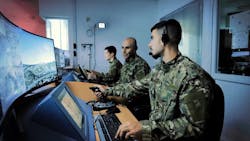Air Force reaches out to industry to apply quantum computing and communications to C4ISR applications
ROME, N.Y. – U.S. Air Force researchers are asking industry to develop quantum computing technology for next-generation command, control, communications, computers, intelligence, surveillance, and reconnaissance (C4ISR) applications.
Officials of the Air Force Research Laboratory Information Directorate in Rome, N.Y., issued a broad agency announcement (FA8750-23-S-7001) last week for the Quantum Information Sciences project to apply quantum information and communications technologies to C4ISR systems.
Quantum computing uses quantum bits (qubits) instead of digital bits. While traditional digital computers are based on binary bits, which either are off or on. Qubits, on the other hand, can exist in off or on states simultaneously, and can enable a quantum computer to perform calculations more efficiently than can traditional computers.
A large-scale quantum computer, for example, could break widely used encryption schemes and aid physicists in performing physical simulations. Quantum computing technology still is in its infancy.
Information scientists believe that quantum computing could lend itself to extremely rapid processing for complex applications like cyber security, C4ISR, electronic warfare (EW), and multisensor processing.
The Quantum Information Sciences project seeks to develop quantum computing algorithms, and to investigate entanglement distribution across a heterogeneous quantum network for military C4ISR.
Research will include quantum algorithms and computing, memory-node-based quantum networking, quantum information processing, heterogeneous quantum platforms, and quantum information sciences.
The Quantum Information Sciences project has five thrusts: quantum algorithm and computation; quantum information processing; memory-node-based quantum networking; heterogeneous quantum platforms; and quantum information science.
Related: Advanced cyber security for C4ISR computer systems is aim of Air Force cyber program
Quantum algorithm and computation involves running quantum algorithms on today's computer hardware such as noisy intermediate scale quantum (NISQ) computers and quantum annealing and adiabatic quantum computers.
Target applications include machine learning, neural networks, optimization, quantum walks, unstructured searches, decision and risk analysis, hybrid classical and quantum algorithms, efficient quantum gate and circuit decomposition and characterization, protocols and algorithms that could be implemented on quantum photonic integrated waveguide chips, superconducting qubit, and trapped ion platforms.
Quantum information processing involves entanglement distribution, quantum information processing, and local and distributed quantum computation. This emphasizes photon-based qubits like quantum integrated photonic circuitry, interactions between photon-based qubits.
Memory-node-based quantum networking includes quantum networking, quantum communication, and quantum information processing with an emphasis on trapped-ion qubits, superconducting qubits, integrated-circuit-based qubits, and entanglement distribution.
Focus areas include multi-node network connections, quantum transduction across frequency bands, interfacing heterogeneous qubit technologies, quantum information mapping between homogenous and or heterogeneous qubit technologies, entanglement distribution, entanglement verification and validation, ultra-high vacuum technology, dilution refrigerator technology, laser development and laser control, and interfaces across different platforms.
Heterogeneous quantum platforms focuses on developing new quantum devices, new functionalities, and exploring fundamental physics of quantum networking architectures.
Prospective research includes cross-quantum technologies for interfacing superconducting qubits and circuitry with ion-trap systems, integrated photonic circuitry, and electromechanical and optomechanical systems; quantum and classical microwave-optical interfaces; development of 3D-integrated heterogeneous quantum architectures; novel chip-scale refrigeration techniques; and approaches to implementing quantum interfaces across large temperature gradients – such as between milli-Kelvin and Kelvin or ambient temperatures.
Quantum information science focuses on quantum communication, quantum networking, and quantum computing. Focus areas are novel quantum bit technologies, quantum protocols for networking and computation, and enabling technology development.
Companies interested should email white papers to the Air Force's Jon Maggiolino no later than 30 Sept. 2023 at [email protected]. Those submitting promising white papers will be invited to submit full proposals. Companies interested also may email white papers until 30 September 2026.
Email questions or concerns to the Air Force's Amber Buckley at [email protected]. More information is online at https://sam.gov/opp/03e6c9dbc79f439aac57fef0cece28f9/view.
About the Author
John Keller
Editor-in-Chief
John Keller is the Editor-in-Chief, Military & Aerospace Electronics Magazine--provides extensive coverage and analysis of enabling electronics and optoelectronic technologies in military, space and commercial aviation applications. John has been a member of the Military & Aerospace Electronics staff since 1989 and chief editor since 1995.
